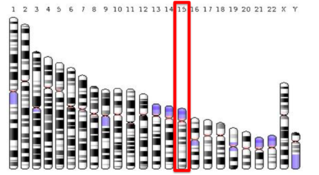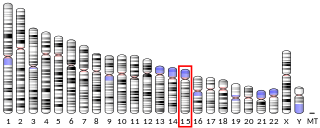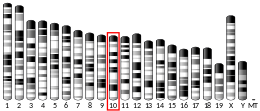
Chitinase domain-containing protein 1 (CHID1) is a highly conserved protein of unknown function located on the short (p) arm of chromosome 11 near the telomere. The protein has 27 introns, which allows for many isoforms of this gene. It has several aliases, the most common of which is Stabilin-1 interacting chitinase-like protein (SI-CLP). As indicated by the alias, CHID1 is known to interact with the protein STAB1. CHID1 is expressed ubiquitously at levels nearly 6 times the average gene, and is conserved very far back to organisms such as Caenorhabditis elegans and possibly some prokaryotes. This protein is known to have carbohydrate binding sites, which could be involved in carbohydrate catabolysis.
LOC105377021 is a protein which in humans is encoded by the LOC105377021 gene. LOC105377021 exhibits expressional pathology related to breast cancer, specifically triple negative breast cancer. LOC105377021 contains a serine rich region in addition to predicted alpha helix motifs.
TMEM156 is a gene that encodes the transmembrane protein 156 (TMEM156) in Homo sapiens. It has the clone name of FLJ23235.

Leucine rich repeat containing 24 is a protein that, in humans, is encoded by the LRRC24 gene. The protein is represented by the official symbol LRRC24, and is alternatively known as LRRC14OS. The function of LRRC24 is currently unknown. It is a member of the leucine-rich repeat (LRR) superfamily of proteins.

Trinucleotide repeat containing 18 is a protein that in humans is encoded by the TNRC18 gene.
BEND2 is a protein that in humans is encoded by the BEND2 gene. It is also found in other vertebrates, including mammals, birds, and reptiles. The expression of BEND2 in Homo sapiens is regulated and occurs at high levels in the skeletal muscle tissue of the male testis and in the bone marrow. The presence of the BEN domains in the BEND2 protein indicates that this protein may be involved in chromatin modification and regulation.

Transmembrane and coiled-coil domains 4, TMCO4, is a protein in humans that is encoded by the TMCO4 gene. Currently, its function is not well defined. It is transmembrane protein that is predicted to cross the endoplasmic reticulum membrane three times. TMCO4 interacts with other proteins known to play a role in cancer development, hinting at a possible role in the disease of cancer.

SHLD1 or shieldin complex subunit 1 is a gene on chromosome 20. The C20orf196 gene encodes an mRNA that is 1,763 base pairs long, and a protein that is 205 amino acids long.

FAM71E1, also known as Family With Sequence Similarity 71 Member E1, is a protein that in humans is encoded by the FAM71E1 gene. It is thought to be ubiquitously expressed at low levels throughout the body, and it is conserved in vertebrates, particularly mammals and some reptiles. The protein is localized to the nucleus and can be exported to the cytoplasm.

Zinc finger CCHC-type containing 18 (ZCCHC18) is a protein that in humans is encoded by ZCCHC18 gene. It is also known as Smad-interacting zinc finger protein 2 (SIZN2), para-neoplastic Ma antigen family member 7b (PNMA7B), and LOC644353. Other names such as zinc finger, CCHC domain containing 12 pseudogene 1, P0CG32, ZCC18_HUMAN had been used to describe this protein.

C15orf39 is a protein that in humans is encoded by the Chromosome 15 open reading frame 15 (C15orf39) gene.

Chromosome 9 open reading frame 25 (C9orf25) is a domain that encodes the FAM219A gene. The terms FAM219A and C9orf25 are aliases and can be used interchangeably. The function of this gene is not yet completely understood.

Chromosome 19 open reading frame 44 is a protein that in humans is encoded by the C19orf44 gene. C19orf44 is an uncharacterized protein with an unknown function in humans. C19orf44 is non-limiting implying that the protein exists in other species besides human. The protein contains one domain of unknown function (DUF) that is highly conserved throughout its orthologs. This protein is most highly expressed in the testis and ovary, but also has significant expression in the thyroid and parathyroid. Other names for this protein include: LOC84167.

LRRIQ3, which is also known as LRRC44, is a protein that in humans is encoded by the LRRIQ3 gene. It is predominantly expressed in the testes, and is linked to a number of diseases.

Chromosome 1 Opening Reading Frame 94 or C1orf94 is a protein in human coded by the C1orf94 gene. The function of this protein is still poorly understood.

KRBA1 is a protein that in humans is encoded by the KRBA1 gene. It is located on the plus strand of chromosome 7 from 149,411,872 to 149,431,664. It is also commonly known under two other aliases: KIAA1862 and KRAB A Domain Containing 1 gene and encodes the KRBA1 protein in humans. The KRBA family of genes is understood to encode different transcriptional repressor proteins

ProteinFAM89A is a protein which in humans is encoded by the FAM89A gene. It is also known as chromosome 1 open reading frame 153 (C1orf153). Highest FAM89A gene expression is observed in the placenta and adipose tissue. Though its function is largely unknown, FAM89A is found to be differentially expressed in response to interleukin exposure, and it is implicated in immune responses pathways and various pathologies such as atherosclerosis and glioma cell expression.

Leucine rich single-pass membrane protein 2 is a single-pass membrane protein rich in leucine, that in humans is encoded by the LSMEM2 gene. The LSMEM2 protein is conserved in mammals, birds, and reptiles. In humans, LSMEM2 is found to be highly expressed in the heart, skeletal muscle and tongue.

In humans, the immunoglobulin super family containing leucine-rich repeat (ISLR) protein is encoded by the ISLR gene. Current RNA-seq studies show that the protein is highly expressed in the endometrium and ovary and shows expression among 25 other tissues. The protein is seen localized in the cytoplasm, plasma membrane, extracellular exosome, and platelet alpha granule lumen. Furthermore, the protein is known to play a role in platelet degranulation, cell adhesion, and response to elevated platelet cytosolic Ca2+.

Family with sequence 98, member C or FAM98C is a gene that encodes for FAM98C has two aliases FLJ44669 and hypothetical protein LOC147965. FAM98C has two paralogs in humans FAM98A and FAM98B. FAM98C can be characterized for being a Leucine-rich protein. The function of FAM98C is still not defined. FAM98C has orthologs in mammals, reptiles, and amphibians and has a distant orhtologs in Rhinatrema bivittatum and Nanorana parkeri.
















